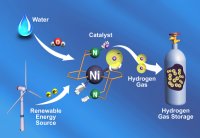Catalyst That Makes Hydrogen Gas Breaks Speed Record
Material designed for energy applications is10 times faster than natural enzyme, uses inexpensive metals
(August 2011)

The record-breaking catalyst stuffs electrons - the backbone of electricity, seen here as yellow balls or yellow halos - into chemical bonds between hydrogen atoms (H) stolen from water. It uses inexpensive nickel (Ni) to do so, instead of the more common and expensive platinum. Enlarge Image
Results: Looking to nature for their muse, researchers at Pacific Northwest National Laboratory have used a common protein to guide the design of a material that can make energy-storing hydrogen gas. The synthetic material works 10 times faster than the original protein found in water-dwelling microbes, the researchers report in the August 12 issue of the journal Science, clocking in at 100,000 molecules of hydrogen gas every second.
Why It Matters: This reaction is just one part of a series of reactions to split water and make hydrogen gas, but the researchers say the result shows they can learn from nature how to control those reactions to make highly active synthetic catalysts for energy storage, such as in fuel cells. In addition, the natural protein, an enzyme, uses inexpensive, abundant metals in its design, which the team copied. Currently, these materials—called catalysts, because they spur reactions along—rely on very expensive metals such as platinum.
"This nickel-based catalyst is really very fast," said coauthor Dr. Morris Bullock, Director of the Center for Molecular Electrocatalysis at PNNL. "It's about a hundred times faster than the previous molecular catalyst record holder. And from nature, we knew it could be done with abundant and inexpensive nickel or iron."
To learn more, read the press release.
Also, you can now view the abstract, reprint, and full text of the article in Science directly, without having to go through the Science member login screen.
Acknowledgments: This work was supported by the U.S. Department of Energy Office of Science.
This work was done by Monte L. Helm, visiting researcher from Fort Lewis College; Michael P. Stewart, R. Morris Bullock, M. Rakowski DuBois, Daniel L. DuBois of PNNL.
Reference: Monte L. Helm, Michael P. Stewart, R. Morris Bullock, M. Rakowski DuBois, Daniel L. DuBois, "A Synthetic Nickel Electrocatalyst With a Turnover Frequency Above 100,000 s-1 for H2 Production." Science 333(6044):863-866. DOI 10.1126/science.1205864.
